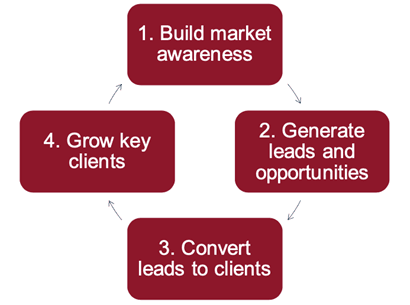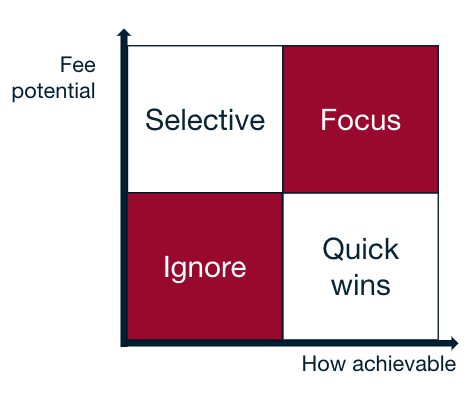Sharpening sales strategy: A practical framework for professional services firms
by David Lewis
Professional services firms are built on their technical expertise. How many of us apply the same professional rigour to the growth of their practices? The following framework offers four practical stages to assess your firm's strengths and weaknesses across the sales cycle - and take action to unlock further growth. This article is based on David’s presentation at the GGI World conference in Lisbon on 21 October 2023.
Four Stages of the Sales Cycle
This step-by-step framework focuses on four interconnected stages of the sales cycle:
Each stage is designed to prompt practical self-assessment and offer strategic focus.
1. Building Market Awareness
During the initial stage, consider questions such as: Who are our future customers? Which market segments should we focus on? What will we be famous for? Do we have key messages that are consistently used and understood across the business?
At USTAXFS, everyone has their own version of what we do, and we are trying to train / persuade everyone to use the same key statements. Our key strengths, or Unique Selling Proposition, is our presence in the same time zone as our European clients and referral partners, our understanding of the European context around their US tax issues, and our attractive rates, compared with big-4 accounting firms, or the big US law firms.
Also consider whether your marketing budget is strategically focused, whether your sales and marketing team has the right size and skill set, and whether your thought leadership is driving genuine visibility and credibility in your markets.
Building market awareness, or brand awareness, doesn’t have to be only about the services you offer. We are using our move to a wonderful new office in central London to host events, including our Office Premiere Party, with a Tax and the Movies theme on 27 August. We hope you can arrange your travel plans to be in London that evening!
2. Generate Leads and Referrals
Lead generation tactics can include building referral networks, Search Engine Optimisation, social media, event attendance, and campaign management.
Ask how effectively we use our CRM system, do our events target the right people, and how do we measure the return on investment from our outreach efforts.
At USTAXFS we rely on our network of lawyers and wealth managers for our private client business, while our corporate sales activities also include direct outreach to potential private equity and venture capital clients. We don’t measure ROI for everything, but we do count the number of new opportunities from each event.
A great example of an effective indirect approach to meeting new clients was a survey of how companies were addressing a topical issue. As well as new leads, this led to thought leadership content that could be used in articles and presentations.
3. Convert Leads into Clients
This stage focuses on the importance of qualifying new opportunities, so only the most attractive and likely successful ones are pursued, including bid management, team selection, proposal writing, pricing and relationship building during the bid.
Ask, how do we assess our strengths and weaknesses across the bid process, from the first meeting, follow-up meetings, our pitch document and presentation(s)? Do we always ask for verbal feedback, whether we win or lose the pitch?
First impressions are important. We try to build credibility through the quality of our questions, and through clear explanations, rather than telling the client how great we are.
4. Grow Key Clients
Our clients may be contacted by other service providers who would love to tempt them away from us. Just as we did when we first met them. The most important step to growing our business is to keep and grow our existing clients. The first building block is the quality of our delivery and our responsiveness to their questions, but we can increase stickiness through relationship building outside an annual compliance cycle. This will include social interactions, lunches, entertaining, but also delivering additional services.
How well does your firm manage key accounts, identify cross-selling opportunities, and build trusted adviser relationships? Tools such as client satisfaction surveys, client portfolio analysis, and “white space” mapping are options to help unlock unrealized potential within existing relationships.
Cross-selling, when aligned with client needs, builds loyalty and creates sustainable revenue. Relationship mapping and portfolio analysis can reveal immediate, low-effort growth opportunities.
A simple analysis of your client base, will show that total annual revenue per client increases disproportionately to the number of services delivered. In other words, if your average revenue per single service client is x, then average revenue from clients where you deliver three services will be more than 3x. White Space Analysis will show which additional services could be offered to each client, as a separate initiative or during your regular catch-up meetings.
Target Market Selection
A practical tool is a two-axis matrix, mapping fee potential against achievability, based on factors such as relationship strength, competitor presence, client need, and budget size. The framework helps identify where to focus business development energy - whether on real estate funds, partnerships with fund administrators, pensions providers, ultra-high-net-worth individuals, or other key referrers.
For example, at USTAXFS we are currently expanding our services to include transaction support for European M&A transactions that include a US owner or subsidiary. We are also positioning ourselves as the US Desk for GGI firms in Europe, and for US firms that seek additional international expertise.
Embedding Measurement and Training
Beyond the four core stages, there are two foundational elements: performance measurement and skills development. Continuous improvement through win/loss reviews, clear sales metrics, and regular training workshops are vital for embedding a sustainable and scalable sales culture across firms.
Takeaways
Improving sales performance in a professional services context doesn’t require radical change - but it does require focus. By stepping back and assessing your firm’s strengths and weaknesses across the sales cycle, you can pinpoint small but powerful shifts that drive meaningful results.
Whether it’s aligning internal messaging, refining lead generation tactics, improving conversion discipline, or deepening client relationships, the firms that grow consistently are those that treat sales as a strategic priority – not a reactive activity.
This framework is designed to start those conversations and shape that thinking. The more intentional we become about how we attract, win, and retain business, the more resilient and valuable our firms will be.
David Lewis is Corporate Development Director at USTAXFS, the largest boutique US tax advisory firm in Europe, serving clients across corporate, funds, trust, and private client sectors. USTAXFS provides international expertise, locally delivered, from offices in London, Zurich and Geneva. David is happy to speak with GGI members about any of these ideas to help them grow their business, and our GGI network.
David gratefully acknowledges the support of Jim Ries of Offit Kurman in his presentation in Lisbon.



/https://storage.googleapis.com/ggi-backend-prod/public/media/6692/David-Lewis---presenting-Lisbon.jpg)
/https://storage.googleapis.com/ggi-backend-prod/public/media/2936/LOGO-USTAXFS-2024.png)
/https://storage.googleapis.com/ggi-backend-prod/public/media/6955/SEO.jpg)
/https://storage.googleapis.com/ggi-backend-prod/public/media/6742/335bd730-5dda-442a-be0a-531002f9556a.jpg)
/https://storage.googleapis.com/ggi-backend-prod/public/media/6738/aa28eda4-8555-42cc-a50f-553925dc585d.jpg)
/https://storage.googleapis.com/ggi-backend-prod/public/media/6737/101f778e-16a0-4035-896f-fbfb81e22e02.jpg)